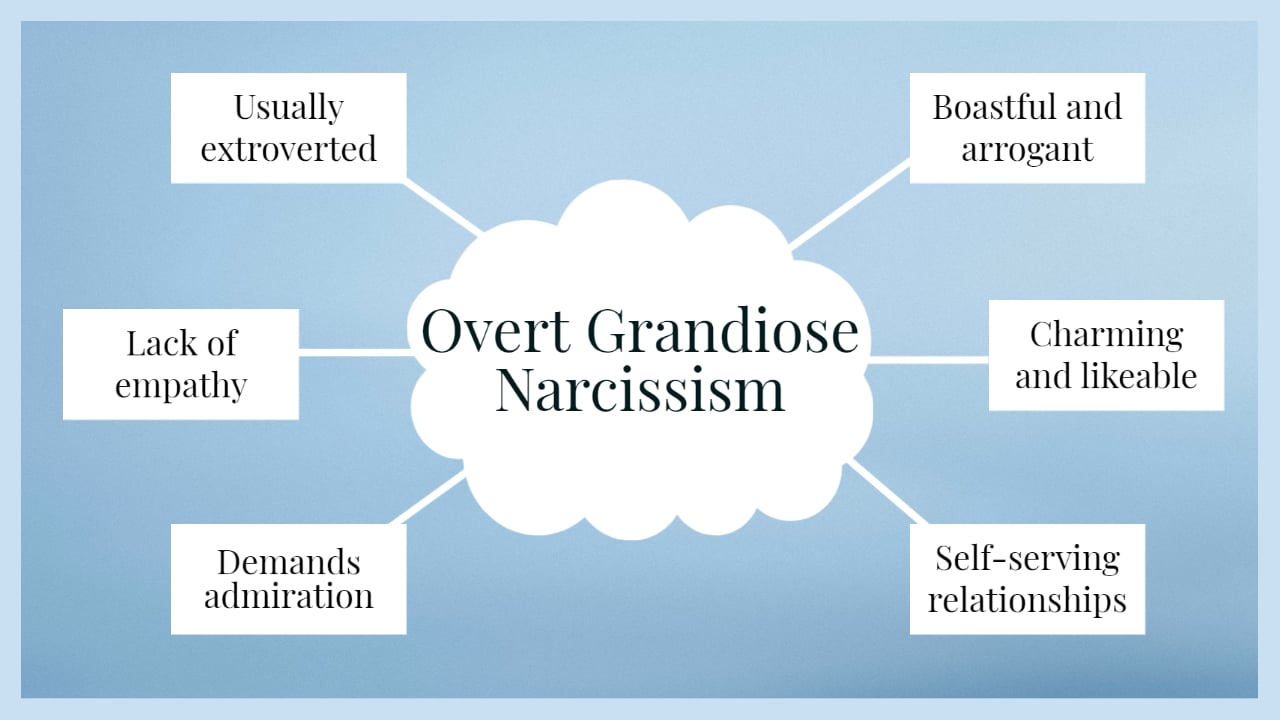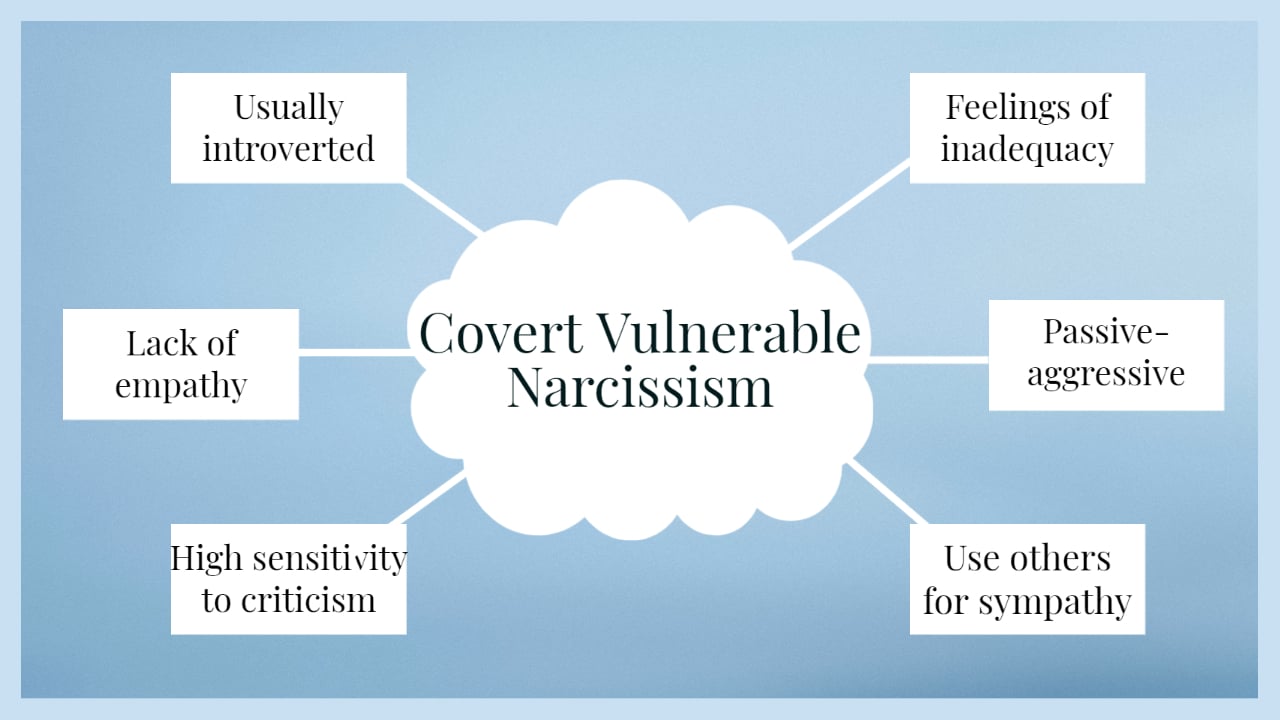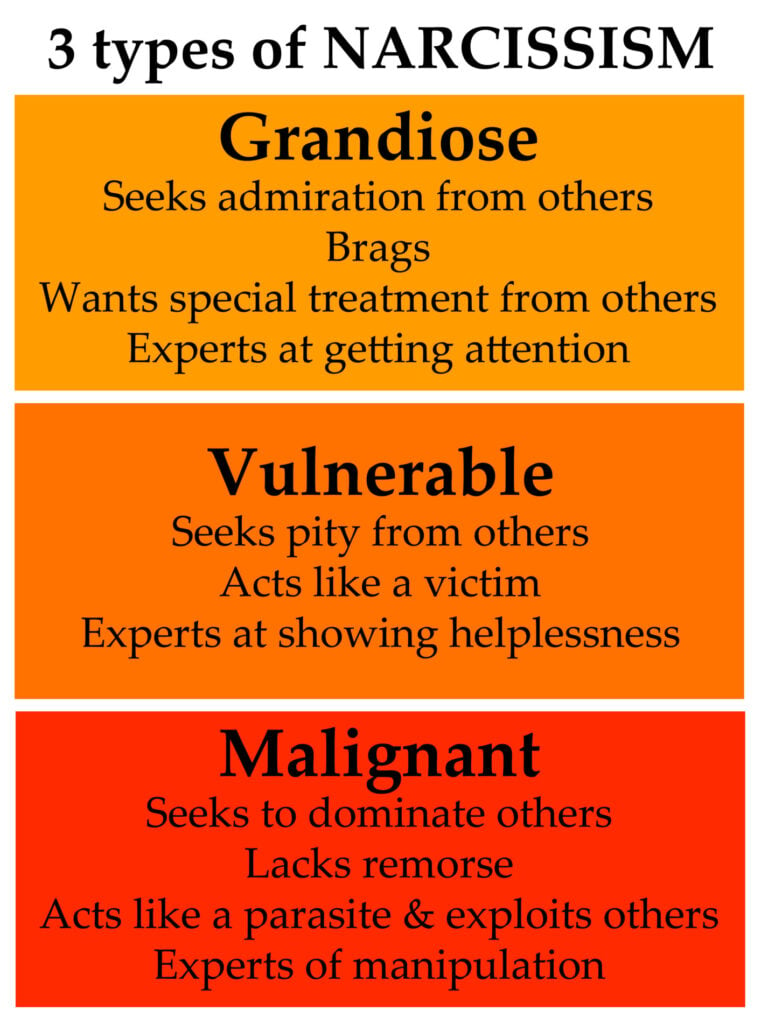On This Page:
Narcissistic personality disorder (NPD) is marked by an inflated sense of self-importance, a constant need for external validation, and a lack of empathy.
People with NPD may exaggerate their achievements and talents and may feel entitled to special treatment. They often have fragile self-esteem and are easily threatened by criticism or rejection.
NPD can significantly impact relationships and personal functioning, but with proper treatment, individuals with NPD can learn to manage their symptoms and improve their quality of life.
Those with narcissism do not necessarily have higher self-esteem or more intense insecurities than those without.
A more accurate representation of those with narcissism is “a pattern of grandiosity, need for admiration, and lack of empathy” (American Psychiatric Association, 2013, p. 645).
However, there remains a debate over whether to view narcissism from a clinical or social-psychological perspective (Foster & Campbell, 2007).
The clinical and social psychology concepts of narcissism share many similarities but differ in one important aspect. In clinical psychology, narcissism is a personality disorder (Foster & Campbell, 2007).

Narcissistic Personality Disorder (NPD) is a mental health condition characterized by a pervasive pattern of grandiosity, a need for admiration, and a lack of empathy for others.
Based on diagnostic criteria, individuals either have a narcissistic personality disorder or do not. Put differently, the structure of clinical narcissism is categorical.
In contrast, social psychologists generally view narcissism as a dimension. According to this view, there is no categorical property to the structure of narcissism.
No point exists along the narcissism continuum where one shifts from ‘‘normal’’ to ‘‘narcissist.” Despite the ongoing debate, for the sake of clarity, this article will focus primarily on the clinical aspect known as narcissistic personality disorder (NPD).
Traits
While it’s not our role to clinically diagnose someone, we can explore the behavioral patterns that may suggest you’re in a relationship with a narcissist.
While these behaviors aren’t definitive proof of narcissism, they are strong indicators. If you’re experiencing these patterns in your relationship, consider seeking advice from a licensed professional. They can guide you on the best course of action for your situation.
Initial Charisma and Love Bombing
One of the first things to note about narcissists is their initial charm. They often leave an excellent first impression, skillfully reading and giving you exactly what you want.
From well-timed jokes to romantic gestures, they can be captivating in the early stages. However, this charm usually wanes over time, making way for more troubling behaviors.
Dominating Conversations
It could be a red flag if your partner seems to monopolize conversations regularly.
This tendency indicates that they believe their opinions are more critical than yours, a clear sign of a grandiose sense of self.
Lack of Genuine Interest in You
Narcissists might ask you questions to appear engaged initially, but their actions often contradict your expressed needs or desires when it matters most.
It could be another warning sign if they’re not truly interested in understanding your preferences.
Craving Admiration and Compliments
Narcissists thrive on external validation. While everyone enjoys a compliment, narcissists depend on them to an unhealthy degree.
Their need for external approval often stems from a lack of self-confidence, making them particularly sensitive to how others perceive them.
Limited Emotional Connection and Empathy
You may notice a lack of emotional depth in a relationship with a narcissist. They’re not particularly interested in your experiences—whether good or bad—unless it serves their image in some way.
This lack of empathy can make the relationship feel very one-sided.
Strained Family and Friendship Connections
An absence of long-term relationships, especially with family and friends, could be another sign.
The difficulties in these connections often stem from the narcissist’s inability to form genuine emotional bonds, which might be traced back to problematic relationships with caregivers during their formative years.
Manipulative Behavior
If your partner continually criticizes you, often out of jealousy or a need to control you, this could be a red flag.
Emotional manipulation can make you change your behavior to avoid conflicts, slowly eroding your sense of self.
Gaslighting
Gaslighting is a form of emotional abuse that may occur in relationships with narcissists, although not exclusive to them.
It involves deliberately undermining another person’s reality, often to the point where the victim questions their own experiences or memories.
Symptoms
The Diagnostic and Statistical Manual of Mental Disorders (DSM-5) categorizes narcissism as a personality disorder that is “dramatic, emotional, or erratic” (American Psychiatric Association, 2013, p. 646).
Such individuals “experience intense emotions or engage in extremely impulsive, theatrical, promiscuous, or law-breaking behaviors” (Salters-Pedneault, 2020).
The diagnostic criteria for NPD, according to the DSM-5, are as follows:
- “Has a grandiose sense of self-importance (e.g., exaggerates achievements and talents, expects to be recognized as superior without commensurate achievements).
- Is preoccupied with fantasies of unlimited success, power, brilliance, beauty, or ideal love.
- Believes that he or she is ‘special’ and unique and can only be understood by, or should associate with, other special or high-status people (or institutions).
- Requires excessive admiration.
- Has a sense of entitlement (i.e., unreasonable expectations of especially favorable treatment or automatic compliance with his or her expectations).
- Is interpersonally exploitative (i.e., takes advantage of others to achieve his or her own ends).
- Lacks empathy is unwilling to recognize or identify with the feelings and needs of others.
- Is often envious of others or believes that others are envious of him or her.
- Shows arrogant, haughty behaviors or attitudes” (American Psychiatric Association, 2013, p. 669-670)
To be diagnosed with NPD, an individual must exhibit five or more of the above symptoms (American Psychiatric Association, 2013).
Furthermore, to be diagnosed, individuals must display “a pervasive pattern of grandiosity (in fantasy or behavior), need for admiration, and lack of empathy, beginning by early adulthood and present in a variety of contexts…” (American Psychiatric Association, 2013, p. 669).
Types
Although there is somewhat of a debate over how many types of narcissism there are, this article will focus on two subclinical subtypes: covert vulnerable and overt grandiose narcissism.
The two share many characteristics; however, they express themselves in very different ways as well.
Overt Grandiose Narcissism

Overt grandiose narcissism is “characterized by extraversion, low neuroticism, and overt expressions of feelings of superiority and entitlement” (Brogaard, 2019, p.1).
Those who are characterized as having overt grandiose narcissism believe they are superior to their peers and that they deserve special treatment. They expect others to cater to their every need.
These types of narcissists generally have good social skills and are hard-working because they strongly desire to be successful. They can become obsessed with wealth and power and focus on getting others to like them.
Covert Vulnerable Narcissism

On the other hand, covert vulnerable narcissism is quite different in some areas. Broggard (2019, p. 2) states that covert vulnerable narcissism “reflects introversive self-absorbedness, high neuroticism, hypersensitivity even to gentle criticism, and a constant need for reassurance.”
This type of narcissism is rarely thought of or described in the media today. An individual with this subtype of NPD typically has characteristics such as being generally fragile and introverted.
People with covert vulnerable narcissism also believe they are better than others. Still, one defining characteristic is that they fear criticism and can even appear panicked when criticized.
Due to these characteristics, these narcissists generally are less successful than their overt counterparts but still imagine themselves as having impressive achievements or high statuses.
These narcissists often suffer from depression and self-pity when criticized and generally struggle to trust others. They often desire others’ possessions or positive attributes and show disregard for others (Emerton, 2020).
Causes
There are thought to be two main causes of NPD, although they still are not well understood: genetics and environmental factors. Many studies on twins have found that genes most likely play a role in the development of NPD (Cain et al., 2008).
Besides genes, many environmental factors are also thought to play a role. A majority of the causes occur in childhood.
Some examples are abuse or neglect, overly high expectations from parents, trauma, rejection, and unpredictable care or neglect (Brazier, 2020). It is also thought that stress can worsen the symptoms of NPD, which may be a causal factor for the disorder.
Treatment
Although treatment for those with NPD can be difficult because these individuals generally do not believe they have a problem, there are options.
The first line of defense, and often best, is psychotherapy. Although the literature on psychotherapy and NPD is still developing, several different types of psychotherapy are used to treat NPD, some of which have been adopted from treatments for borderline personality disorder.
Transference-focused psychotherapy (TFP) can be a great option for NPD patients (Tartakovsky, 2017). This psychodynamic therapy, a type of therapy that “focuses on unconscious processes as they are manifested in a person’s present behavior” (Substance Abuse and Mental Health Administration, 1999, p. 1), focuses on the relationship between the clinician and client as well as the client’s relations with the outside world.
The treatment begins with a verbal contract between the two, laying out each member’s roles and responsibilities during treatment. The clinician and the client work together to navigate through any issues the client has.
Another option for those with NPD is schema-focused therapy (Tartakovsky, 2017). This therapy combines psychodynamic therapy with cognitive behavioral therapy (CBT), which is “a short-term, goal-oriented psychotherapy treatment…” whose goals are to “…change patterns of thinking or behavior that are behind people’s difficulties, and so change the way they feel” (Martin, 2016, p.1).
Schema-focused therapy helps replace unhealthy schemas (how the client organizes and interprets information) (Tartakovsky, 2017).
Mentalization-based therapy (MBT) can also be helpful for those with NPD (Tartakovsky, 2017). This psychodynamic treatment helps those with NPD better reflect on their thoughts as well as the thoughts of others.
Also, dialectal behavioral therapy (DBT) has proven effective for many disorders, including NPD. This form of CBT “focuses on mindfulness, emotional regulation, distress tolerance, and relationship skills” (Tartakovsky, 2017, p. 2).
A type of therapy specifically designed to treat individuals with NPD is metacognitive interpersonal therapy (MIT). In MIT, there are two stages: stage setting and change promoting.
Stage setting involves “gaining a deeper understanding of the person’s interpersonal relationships by exploring different situations, memories, and recurrent patterns,” while change promoting “includes showing individuals that their ideas do not necessarily mirror reality and that situations can be understood differently when seen from another angle, along with building new and healthier ways of thinking, feeling, and behaving” (Tartakovsky, 2017, p. 2)
The final therapy typically used to treat NPD is called supportive psychotherapy. It combines psychodynamic therapy and CBT. Supportive psychotherapy’s goals include stabilizing the individual, addressing comorbid conditions, and, given the condition the patient is in, attaining the highest possible level of functioning (Tartakovsky, 2017).
In more severe cases of NPD, medication may be required as well. Clinicians may prescribe mood stabilizers, antipsychotics, or antidepressants to treat NPD patients.
However, individuals with NPD often struggle to take their prescribed medications because they tend to be highly sensitive to the side effects of their medication (Tartakovsky, 2017).
Dealing with Someone With NPD
Being in a personal relationship with someone who has NPD can be challenging; however, it is possible. Here are a few steps to take when interacting with someone with NPD.
One of the first steps is to avoid having any particularly negative interactions with the individual personally (Clarke, 2020). This can be difficult given the individual’s lack of empathy, sense of entitlement, deceptive behaviors, and manipulative patterns.
Another key step to take is to set boundaries. Those with NPD often do not have healthy boundaries (Kacel et al., 2017). Although it can be scary and difficult, setting boundaries lets those with NPD understand that those who care for them have strong personal values.
Taking care of oneself is important as well. Try practicing yoga, meditation, getting enough food and rest, or doing things one enjoys. It’s important to take care of oneself first before one can care for another.
If the relationship becomes too stressful to self-manage, individuals are encouraged to seek help. Psychotherapy may help set and maintain boundaries, navigate stress, and feel validated.
If none of these steps are working effectively, the last option is ending the relationship. This can be an especially important step if the relationship is unhealthy or abusive. It is important to self-reflect and be honest. If need be, taking a step back may be the best option.
Measuring Narcissism
The best way to measure narcissism is still up for debate. There are many options to do so. Some use the Thematic Apperception Test (TAT) to assess for NPD.
Sometimes known as the “picture interpretation technique,” TAT is a projective test developed in the 1930s at Harvard University by American psychologists Henry A. Murray and Christina D. Morgan.
This means that a series of ambiguous scenes, words, or images are presented, and individuals’ responses to these stimuli are recorded and analyzed.
A popular example of the TAT is instructing an individual to tell a dramatic story after viewing a series of picture cards showing several ambiguous characters, scenes, and situations.
The TAT, in its complete form, consists of 31 different cards, although Murray originally recommended using only 20 of them and choosing cards that revealed characters similar to the topic at hand.
Today, practitioners use between five and 12 cards typically chosen because the professional believes that the scene depicted matches the client’s needs or situation.
One of the main criticisms of TAT is that there is no standardized scoring system. Murray recommended a complex one, but many practitioners have chosen not to use it and subjectively interpret the results themselves. Furthermore, there are various ways in which clinicians administer the test. All of this variability has led to some scrutiny over TAT.
Another option that practitioners have used to measure NPD is the Rorschach inkblot test. The Rorschach inkblot test, another type of projective test, was created by Hermann Rorschach in Switzerland in 1995.
The test is most commonly used to assess personality and emotional functioning. In Psychodiagnostik, a 1921 book published by Rorschach, he identified ten inkblots useful for diagnostic purposes. In practice, these black, white, gray, and sometimes colorful inkblots are shown to the client and asked to interpret what image they are being shown.
In this book Psychodiagnostik, Rorschach described how to score the test as well. Since then, many other scoring systems have been developed and are commonly used today.
The common threads among the scoring systems are scales assessing how participants describe the image, how long they take to respond, extra or unrelated comments spoken, and the originality of the responses given.
Similar to the TAT, though, the Rorschach test has a wide variability in its standardization of ways in which the test is administered and in its scoring systems. This has led to poor validity and reliability surrounding the test.
There are several other ways to assess for NPD as well. Some use linguistic clues like first-person singular nouns in conversation and written components (Konrath et al., 2014). Others use tests such as the Diagnostic Interview for Narcissism. This interview technique evaluates the five major domains of function: “interpersonal relations, reactiveness, affects and moods, grandiosity, and social and moral adaptation” (Gunderson et al., 1990, p.1).
However, despite this wide array of assessments, the most common way to measure NPD is through self-report measures. An example of one of these self-report measures is The Millon Clinical Multiaxial Inventory (MCMI-III). The MCMI-III measure is used to detect NPD and was developed by Theodore Million.
It is made up of 175 true-false questions (Axelrod, 2016). Typically, the MCMI-III takes clients around 30 minutes to complete this test. Upon completion, the test produces 24 personality and clinical scales, which assess for NPD, and five scales used to verify how the person took the test.
Of these popular self-report assessments, though, the most common is the Narcissistic Personality Inventory (NPI). This test measures overt and grandiose aspects of narcissism (Konrath et al., 2014).
The test contains 40 different self-choice statements, such as “If I ruled the world, it would be a better place” or “The thought of ruling the world frightens the hell out of me” (Konrath et al., 2014, p. 3).
Once a client reaches a certain threshold on the NPI scale, they are then determined to have NPD. Lastly, there are several other self-report measures that assess for NPD as well, such as the Hypersensitive Narcissism Scale (HSNS), the Five Factor Inventory Scale (FFNI), and the Pathological Narcissism Inventory (PNI).
Do you need mental health support?
USA
Contact the National Suicide Prevention Lifeline for support and assistance from a trained counselor. If you or a loved one are in immediate danger: https://suicidepreventionlifeline.org/
1-800-273-8255
UK
Contact the Samaritans for support and assistance from a trained counselor: https://www.samaritans.org/; email jo@samaritans.org .
Available 24 hours a day, 365 days a year (this number is FREE to call):
116-123
Rethink Mental Illness: rethink.org
0300 5000 927
Further Reading
References
Cain, N. M., Pincus, A. L., & Ansell, E. B. (2008). Narcissism at the crossroads: Phenotypic description of pathological narcissism across clinical theory, social/personality psychology, and psychiatric diagnosis. Clinical Psychology Review, 28 (4), 638–656.
Emerton, N. (2020, January 08). Narcissistic personality disorder – overt and covert. Retrieved September 08, 2020, from https://www.beu.org.uk/new-blogs/2020/1/8/narcissistic-personality-disorder-overt-and-covert
Foster, J. D., & Campbell, W. K. (2007). Are there such things as ‘“Narcissists”’ in social psychology? A taxometric analysis of the Narcissistic Personality Inventory. Science Direct, 1321–1332.
Gunderson, J. G., Ronningstam, E., & Bodkin, A. (1990). The diagnostic interview for narcissistic patients. Archives of General Psychiatry, 47 (7), 676–680.
Kacel, E., Enis, N., & Pereira, D. (2017, August 2). Narcissistic Personality Disorder in Clinical Health Psychology Practice: Case Studies of Comorbid Psychological Distress and Life-Limiting Illness: Behavioral Medicine: Vol 43, No 3.
Konrath, S., Meier, B. P., & Bushman, B. J. (2014). Development and Validation of the Single Item Narcissism Scale (SINS). PLoS ONE, 9 (8).



